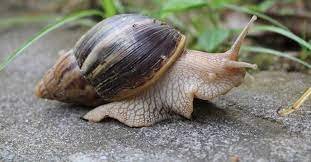
Prepare IAS Coaching
Current Affairs

Title : THE GIANT AFRICAN SNAILS (Prelims Specific Topic)
Date : Nov 30, 2021
Description :
- About the Giant African Snail:
- The Giant African Snail (Achatina fulica) is a big land snail with a binomial name of Achatina fulica. It feeds aggressively and harms agricultural crops as well as natural flora.
- As the name implies, giant African snails are native to East Africa.
- The snails have a height of about 7 cm and a length of roughly 20 cm.
- The snail's shell is conical in shape and twice as tall as it is wide. The shell is also extremely durable.
- Plants, vegetables, fruits, paper, and cardboard are claimed to be eaten by snails. They also eat sand, very small stones, and cadaver bones on occasion.
- The International Union for Conservation of Nature has designated the snail as one of the worst invasive species (IUCN).
- Human diseases such as septicemia, eosinophilic meningitis, and peritonitis are thought to be transferred by the Giant African Snail.
- Invasion of Giant African Snails in India:
- According to a recent study, the gigantic snail species has repeatedly entered India, notably Kerala.
- The research was carried out at the Kerala Forest Research Institute (KFRI) in collaboration with the Kerala State Council for Science, Technology, and the Environment (KSCSTE), the UAE's Environmental Agency, Nottingham University in the United Kingdom, and the Natural History Museum in London.
- The research was carried out between 2016 and 2020.
- The snail is supposed to have arrived in Kerala after a researcher released them by accident in Palakkad in the early 1950s. In the 1970s and 2005, there were two further waves of invasion.
- Except for Idukki, the deadly species has now spread to all of Kerala's districts.
- In comparison to native African species, India has a greater genetic diversity of large African snails, according to the study.
- The genetic strains of big African snails in the UAE and India are the same. This can be attributed to the movement of goods between the two countries.
- The study's findings were published in the Linnean Society's biology magazine.
- Source à The Hindu à 30/11/21 à Page Number 7